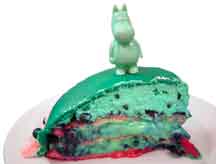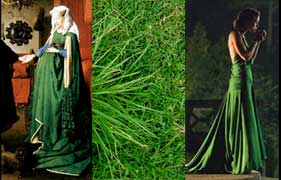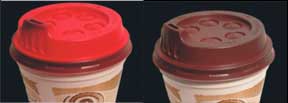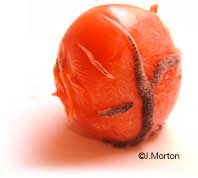Here are some Blog entries from April - June, 2008
Blog Archives 2: April - May 2008
Gagging on Green?
April 6, 2008
With the arrival of spring in the Northern Hemisphere, delicate and dramatic shades of green are everywhere. This reinforces our awareness of the environment and the latest news about "green" (ecologically beneficial) products and efforts. It almost seems that any opposition to the color green could be deemed anti-earth. Just for the fun of it, let's put this on pause and play with the unappetizing attributes of green. For example, "split pea" green can sicken the viewer. Bright green may be acceptable as Astroturf, but what about green as in "sleazy motel carpet"? Just for the record, green (with a yellowish cast) is not a good color in situations where motion sickness can occur such as the interiors of passenger trains, planes, and boats.

As for sweets, if you frost cupcakes with various colors, green will be the last one chosen, unless you have some blue ones. Lime, mint and pistachio ice creams are inviting, but what about yellowish green?
Green is no longer just a color
April 14, 2008

“Green Is 'In' Color For Babies” ... “Green-collar jobs,” ... “Green Innovations from the City Council” - these are just a few of the examples of the use this buzzword for “ecologically friendly.” Some say there is evidence of eco-fatigue from the greenification of sales pitches for products. What do you think?
Others ask how green beat out blue as a symbol of our planet. Is green really the dominant color?
Who owns green apples?
April 21, 2008

The City of New York - which has been known as “The Big Apple” since the 1920s - is running a campaign called "GreeNYC to encourage New Yorkers to take steps to reduce greenhouse gases. City officials hired the New York design firm Turf to designed a stylized ‘infinity apple’ design, as a symbol of New York’s campaign. (It's the green design at the left at the top of this article.)
Apple computer is complaining that the chosen image comes far too close to its own iconic apple logo. The New York logo, although it is clearly an apple with a leaf in basic shape is green and bears little resemblance to Apple’s silver or white logo (with the signature bite mark) of the iPod, iPhone and iMac and other Macintosh devices. (Apple's logo is the design at the right at the top of this article.)
Apple Inc. clearly doesn’t see it that way. According to a complaint filed with U.S. Patent and Trademark Office, Apple states that the New York logo design will lead to “consumer confusion resulting in damage and injury” to Apple while also causing “dilution to the distinctiveness” of the Apple trademark.
Green with envy? This is the color of greed. Not only is the design radically different from the Apple logo (which originated in 1976), the apple was a symbol of NYC long before Steve Jobs was born.
Use of the logos in this article complies with fair use doctrine under United States copyright law.
For more information, see "Who Owns Hues?" - Color & Trademarks" at this web site.
It's Not Easy Wearing Green
April 28, 2008

First there was the green wedding gown in Van Eyck's painting of “Giovanni Arnolfini and His Bride” from the Renaissance. She’s not pregnant; she's slouching in imitation of her willingness to bear children - and she’s wearing green as a symbol of her fertility.
These strong associations still exist in Europe today. By the time of King Henry VIII, in England, green also symbolized unfaithfulness. This related to the grass stains on a 'virgin's' clothing. (Coincidentally, in China, a green hat symbolizes that a man’s wife is cheating on him.)
In 2008 we have the infamous green gown worn by Keira Knightly in Atonement. Some say she looks like a preying mantis or an advertisement for St.Patrick’s day. Others say that this 1920s socialite dress is one of the best film costumes of all times. We can only pause to ask if this green gown would have the same impact if “Ugly Betty” wore it.
The context is everything - the historical and cultural context and who wears it.
Advertisement

Download immediately. Click here !
Colors Are Key To Keeping Life Simple
May 6, 2008

Unfortunately the human brain limits our ability to focus attention on only three objects at once. Psychologists at Johns Hopkins have found that color can enable you to focus on 70 objects at once. A new study demonstrated that when players wear uniforms, it allows spectators, players and coaches at major sporting events to overcome the “three objects limit” because the common color of uniforms allows them to perceive separate individuals as a single set.
If you want to keep track of many things at once, make them be the same color. Yes, color matters!
Source - Watch the two minute video!
What Your Car Color Says About Your Psyche
People whose car color is red have confidence that is 8% below average!
May 14, 2008
Just when we thought there was no terrain left for the tiresome topic of “What Your Favorite Color Says About You,” an automotive color-coding poll presents some unusual findings about what your car color says about your psyche.
The results of the survey reveal the degree of mood swings and the confidence of the car owner. For example, black, dark blue or silver reflects personalities with consistent moods. Emerald green and yellow correlate with people with the most pronounced mood swings.
As the owner of a new silver Scion XD, my color choice was based on the availability of colors and resale value. Frankly, I’d agree with others that this survey is full of faulty logic.
However, you might use the findings to cast some light on whether your lawyer is worth the $300 hourly fee and whether you should get out of the way of that emerald green car that fills your rearview mirror. USNews Source
Award-winning Smart Color
May 26, 2008

In the midst of an excess of color-coding, here’s one that really works and it even won an award. It’s the color changing coffee cup lid that alerts consumers their coffee may be too hot by its bright hot red color. As the coffee cools, the lid turns a safe brown.
Yes, great coffee deserves great – and smart - packaging. Yes, color matters in packaging and this lid goes far beyond the idea of great design. It FUNCTIONS! In fact, Smart Lid Systems, the inventors of the disposable color changing coffee lid, have been awarded the 'Best of Show' AmeriStar Packaging Award, which is considered the Oscars® of the packaging industry.
Your daily coffee can now be a more colorful experience as you watch it morph to bright red then change back to a dark brown as it cools.
Coloration is Communication
June 3, 2008

What if we humans could change color in the same way that those coffee lids (below) send a signal that the coffee is too hot to handle ? What if we could use color to express our unwillingness to mate, or territorial prerogative, or any stress? In other words, how about some chameleonic human color.
We know that chameleons have a unique ability to change their skin color to blend in with their surroundings for the purpose of avoiding predators. But research conducted by Devi Stuart-Fox and Adnan Moussalli shows that camouflage is not the entire function. They reported that lizards communicate with each other via changes in their color ... that the color shifts rapidly signal to other chameleons an unwillingness to mate or a desire to seduce or territorial dominance.
Another chameleon experts, Christopher Raxworthy observed the following:
"Males become more brightly marked to advertise their dominance. Females become dark or flash red spots to advertise their hostile response to males or their non-receptive status. Aggressive chameleons may become very dark."
The scientific basis of this ability is a neurological control mechanism that stimulates the pigments to move around and cause the chameleon's skin color to change. Unfortunately, we humans are only able to blush - and uncontrollably at that. What if we could “turn purple with rage” or “green with envy” as our language so colorfully expresses some emotions?
Source:
How Social Signaling Drives Chameleon Color Change
Artificial Colors and Testosterone
June 10, 2008

The colors of a bird’s feathers communicate status and send sexual signals. Unlike humans - who may color their hair to appear more attractive, younger, or otherwise - a bird’s coloration is natural. In other words, the colors of the feathers are the result of physiological characteristics - such as a bird’s hormonal profile. And birds don’t have the ability to bleach or dye their feathers in ways that humans do.
Therefore, it would be safe to assume that if we artificially colored the feathers, this would not change a bird’s behavior or physiological make-up. Think again. A team of scientists artificially colored the chests of male barn swallows with a non-toxic marker to match the darkest, most attractive feathers of males within the population. The experimental coloration didn't just improve the males' looks in the eyes of the females, it actually changed the males' body chemistry. The testosterone levels of the manipulated birds soared in a short period of time. We can't help but wonder why we can't do the same with human hormones ... for higher purposes, of course.

Credit: University of Colorado, Boulder)
An earlier study by the same team showed male swallows that were "made over" with darker breast colors bred earlier in the season and fathered more young, and the females that chose them cheated less often with other male suitors.
It's a "clothes make the man" lesson that -- with some caveats -- also applies to human males.
Source: ScienceDaily (Jun. 3, 2008)
The Competitive Edge of Red
June 18, 2008
Two years ago the journal Nature published results of a British study showing that teams wearing red have a higher probability of winning than teams wearing blue. Just for the record, this was a very scientific study based on the performance of Olympic wrestlers.
Researchers have just discovered that the red team has a better chance at winning than the blue team in online games. Scientists studied the results of 1,347 games between top teams playing "Unreal Tournament 2004" - a game based on running around and shooting at the avatars of the opposing team. The red teams won 55% of the time.
Neuroscientist Mihai Moldovan of the University of Copenhagen in Denmark said the reason was most likely that the color red may act as a psychological distractor for men, possibly because men flush and turn red when they're angry.
Am wondering if we could combine the results of the bird study from last week’s blog (below) with this one. Could painting the chest of a male human in the real world give him a competitive edge? Source
Advertisement

Wearing Red = A Competitive Edge in Germ Warfare
June 28, 2008
Bright red protective uniforms for hospital workers or the military and even everyday underwear may someday have powerful germ-fighting properties.
Researchers at the University of California, Davis found a strain of marine bacteria that produces large amounts of red pigment that can color clothing and guard against harmful bacteria. Lab tests showed that most of the dyed fabrics they tested had the ability to kill both E. coli and S. aureus bacteria.
How about a lipstick that creates a barrier to germs! The dye may even be used in makeup as a natural alternative to the pigments used today.

What’s next? Perhaps we will be able to genetically modify vegetables ... and create a brilliant red tomato that will never be the source of a salmonella outbreak as we know it today.


